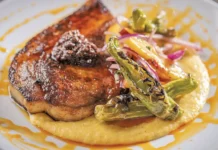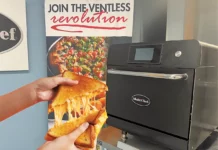What do you do when you love both books and food? You open a bookstore that carries beloved cookbooks and tomes on healthy diets and American gastronomy and the evolution of brewing beer and professional baking and chefs and restaurants, like Matt Sartwell and author Nach Waxman of Kitchen Arts and Letters in Manhattan, that’s what.
Where did the idea come from?
Waxman: I was at a division at Random House and I decided I simply wanted to get out of the corporate world. And this happened to coincide with the surge in food interest, even though I wasn’t really thinking about it. So, I decided I was going to do a specialized bookstore in food and wine and that its major characteristic was not just going to be about cooking – cookbooks and things like that – but everything about food, from the culture and history of food to food science to the restaurant industry. Anything you can think of that touches on the world of food is at Kitchen Arts and Letters.
Who did you want to appeal to?
Sartwell: From the beginning it was also the idea that the core customers were going to be a wide range of professionals, from agriculturists to food scientists to just about anyone interested or involved in food. It’s way more than just a professional chef. There’s a whole world beyond that.
Waxman: Everybody from cooking teachers to farmers to people in food manufacturing and packaging design. That’s always been a part of the design of the store.
What are your biggest sellers?
Waxman: This year our biggest sellers have been books out of Scandinavia. I think it would have been very difficult for people to imagine that that was an interesting part of the world 15 or 20 years ago. But now that they know that there’s a lot of creative ferment going on there, they’re really interested in seeing what happens there. At the same time, if the new techniques start to surface someplace else, people are going to be interested in that, too, like what the Spanish were doing. People wanted to grasp it and put it to their own purposes.
So we were going after books like that for multiple reasons. Our customers are usually pretty clear with us about what they want and if we don’t have it, we’re on the trail of it pretty quickly.
What are your customers most interested in?
Waxman: Sometimes they’re looking in specific areas. Either a geography or a region of the world. But more often, it’s amazing how broad their tastes are, and what they’re willing to consider. Because what they’re really looking for is spice. They’re looking for, how do we spice something, in the literal sense.
They’re looking for sparks, or inspiration. And obviously they’re buying books very differently from the way people who need a recipe for turkey stuffing or huckleberry pie. We’re happy to serve those people, as well, but certainly the challenge much more is getting people who want to be excited about something.
Sartwell: We do spend a lot of time with people finding out what it is that motivates them. Some people have to have every latest new thing and they get kind of itchy if they feel like a new book has come in and they haven’t had a chance to look at it. Others are much more deliberate and they’ll spend a lot of time coming back and asking questions. So, we work both ways, either by phone or in person or email with those people. To alert them to stuff that they might be very happy with.
Do chefs ever recommend your book store to their workers?
Sartwell: The number of people who are sent here by their chefs is absolutely delightful. For some of these people, it’s really the beginning of their education because they didn’t go to culinary school. They’re in there hauling pots around or trimming vegetables. And if they look like they’re enterprising and they look like they have intelligence, the chef will say to them, why don’t you learn something about cold table. They do come in and that’s very exciting for us. That’s very gratifying. Helping someone get a start.”
Do amateur cooks find their way to your store?
Waxman: Though most of our customers are from the professional side of things, there are always people who are just interested in food. We do certainly see people who call themselves foodies. But they tend to be content here with the same things that are exciting the professionals. And if we say to them, this is the book that the chefs are really interested in, you can see their eyes light up. And they’re happy for the chance to look into that world.
Sartwell: Home cooks also come. “People who really are seriously interested in doing good cooking either in attempting to duplicate stuff that they have tasted in great restaurants or at least use as a springboard or even to work innovatively themselves without an intention necessarily of going on to turn themselves into kitchen slaves, like to come in.
With the whole world going digital, do you see the end of the printed page?
Sartwell: There are types of books that are indeed vanishing in printed form all the time because they do just as well in electronic versions – restaurant guides, for instance. There are printed books, however, where that’s not the case and cookbooks particularly offer the thrill of the new and the excitement and exposure to something you may never have had before, the tactile experiences of opening the book and browsing it. What you can do with a particular type of food, that sort of thing, a book still works the best and certainly for our chef customers there’s no question that the inspiration doesn’t come from something on the screen. It comes from holding that book being able to flip around being able to look at this picture, that picture.
Waxman: You can’t beat the Web, simply because of the massive indexing capacity – and the books which give an integrated treatment to a subject, that has a viewpoint. To teach not a recipe about how to make a chicken curry, but put it into a perspective of Indian cuisine and what are curries and how many Indian dishes really are curries and how many are really something else.
I suppose it is possible but quite honestly it would probably be more tedious and more work to do that from an electronic source. There is a big difference between recipe research – it’s hard to surpass what you can do online simply because of the massive indexing capacity – and the books which give an integrated treatment to a subject, that has a viewpoint. I suppose it is possible but quite honestly it would probably be more tedious and more work to do that from an electronic source.
What’s in the future?
Waxman: The online business is going to get friendlier and easier for people to use. And we’re also going to try and use it to attract a wider range of things from places we haven’t been able to reach yet. I hope that our success with that will convince some smaller-scale publishers in other countries to engage with us a little more. We’re also running a series of events at the 92nd Street Y. We just started our second year and the events go all over the place. We have smaller-scale events on home-cooking subjects but we also bring in a great range of professional people. This year we had 650 people! We may have some consumers in the audience but we have to make sure that every season’s line-up has books with authors that might otherwise not have much of a chance of getting out there. That’s going to continue to be a way to call attention to the smarter, more ambitious professionally-oriented books.
Sartwell: What you can do with a particular type of food, that sort of thing, a book still works the best and certainly for our chef customers there’s no question that the inspiration doesn’t come from something on the screen. It comes from holding that book being able to flip around being able to look at this picture, that picture.























